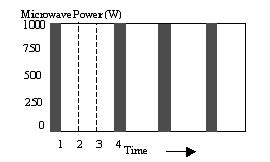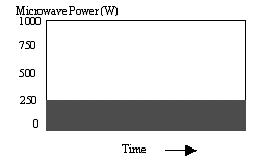|
<Feature
of conventioal Microwave Furnace>
Conventional
Mircowave Furnaces have a problem in matching real
temperature with setting temperature
not only during raising temperature
but also during maintaining fixed temperature.
The temperature deviation can be resulted
in a couple of reasons.
One
of the most important reasons is that temperature
rise and fall are occuring too rapidly.
Temperature rises quickly when a magnetron
is on and then falls fastly when a magnetron
is off. Therefore, reducing temperature
deviation by controlling a magnetron is
not a simple method.


<Fig.
1> <Fig.
2>
<Fig.
1> and <Fig. 2>, respectively,
show different mechanisms which can be employed
to Microwave Furnace. <Fig. 1> shows
the On/Off control type. In this figure, temperature
rises quickly when microwave is radiating(black
section) and temperature falls swiftly when
microwave disappears(white section). Thus,
precise temperature contol is difficult.
<Fig. 2> shows Variable Power Microwave
Systems(VPMS) which was developed to improve
temperature equality. This method continuously
change power of magnetron between 0¡100%,
consequently temperature deviation is narrower
than On/Off control method. However, VPMS
method also has a weak point that its response
speed to magnetron power control is sluggish
because it drives stub by mechnical
manner such as a motor. As a result, this
method is not suitable for use in rapid
temperature rise in which power control
should be accomplished quickly. After all,
precise temperature control which is practicable
in an electric furnace is technically difficult
in a conventional Microwave Furnace, and
producing equipment to achieve accurate
temperature control will cost a lot of money.
In
spite of many advantages over a electric
furnace and a gas furnace, Microwave Furnaces
are not widely used because precise temperature
control is crucial for adjusting mechanical,
electircal properties of ceramics and metals.
<Microwave
Furnace of UNICERA>
To
solve this problem, the Microwave Furnace
of UNICERA adopts Micro-Time-Slicing mechanism.
This
mechnism control the cycle of manetron On/Off
in microscopic time. The cycle of Mico-Time-Slicing
mechanism is smaller than 1 second.
This is much shorter than the cycle of conventional
On/Off mechanism, for example 7 seconds.

<Fig.
3> shows one example of the cyle of magnetron
On/Off controlled by Micro-Time-Slicing
mechanism. <Fig. 4> represents actual
Microwave power radiating an objects which
is the result of <Fig. 3>.
To
control magnetron power in microscopic time,
Microwave Furnace of UNICERA adopts temperature
controller which utilizes Micro-Processor
and Operating Program. One operating pulse
cycle consists of On and Off period. Operating
pulse cycle and each On/Off period can be
adjusted by an operator or operating program.
For example, if an operating pulse
cycle is 0.01 second, we can adjust such
as that 25% of the cycle is On
period and 75% of the cyle is Off period.
Operating time of UNICERA's Microwave Furnace should be set between
0.0001 ¡ 1 second. If operating time is
shorter than 0.0001 second, magnetron power
might be unstable. If operating time is
longer than 1 second, temperature deviation
problem might be occurred just like in conventional
On/Off control mechanism.
In
addition, our company's Microwave Furnace
can change the ratio of On/Off periods during operating.
That is, Micro-Processor loaded in Furnace
can control dynamically the ratio of On/Off
periods according to measured temperature
and programmed temperature schedule. For
example, if measured temperature is higher
or lower than programmed temperature, Micro-Processor
decreases or increases the ratio of On period
of the cycle.
|
